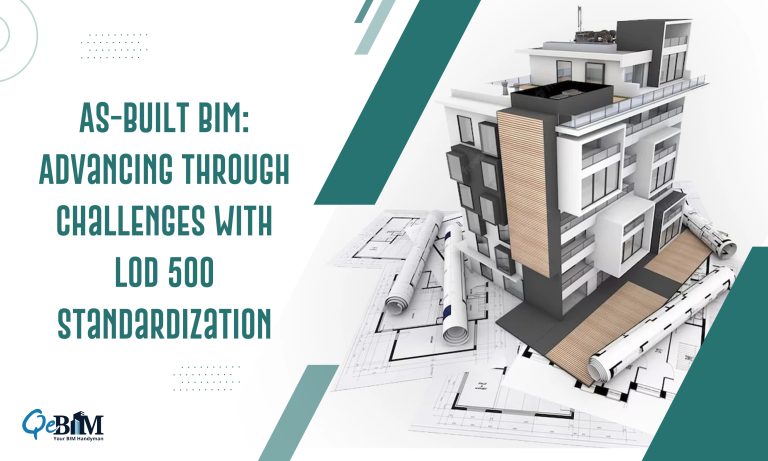As-Built BIM: Advancing Through Challenges with LOD 500 Standardization

In the construction and architectural domain, BIM has emerged as a transformative force, streamlining processes, enhancing collaboration, and improving project outcomes. Among the various stages of BIM implementation, the utilization of As-Built BIM Services stands out as a critical phase, bridging the gap between design intent and reality. However, this phase often encounters its share of challenges, which are being met head-on through innovation and the standardization of Level of Development (LOD) 500.
What is As-Built Technology?
As-Built BIM technology refers to the process of capturing accurate data about the built environment and integrating it into the BIM model. This data provides some of the valuable insights that can be of great use for the facility management, renovations, and future constructions. However, achieving accurate As-Built BIM models presents several challenges, including outdated documentation, discrepancies between design and construction, and the lack of standardized processes.
Challenges of As-Built BIM
One of the primary challenges in As-Built Drawing Services is the reliance on outdated or incomplete documentation. As-built drawings and specifications may not accurately reflect the changes made during the construction process, leading to discrepancies between the digital model and the actual building. This issue is compounded in renovation projects or structures with a long history of modifications.
Furthermore, variations between the design intent and the constructed reality pose significant hurdles. Changes made during construction, discrepancies in measurements, and unforeseen site conditions can deviate from the original BIM model, resulting in inaccuracies that compromise the model’s usefulness for future projects.
Addressing the Challenges with Technology and Standardization
To address these challenges, the industry has turned to innovation, leveraging advanced technologies to enhance the accuracy and efficiency of As-Built BIM processes. Laser scanning, drones, photogrammetry, and handheld devices equipped with augmented reality are among the tools revolutionizing data capture in the field. These technologies enable precise measurements, comprehensive documentation, and real-time updates, facilitating the creation of highly accurate As-Built BIM models.
In addition to technological advancements, the standardization of LOD 500 has played a crucial role in overcoming challenges in As-Built BIM. LOD 500 represents the highest level of development, indicating a model with accurate geometry and comprehensive data for all elements within the building. By standardizing LOD 500 requirements, industry stakeholders can ensure consistency, reliability, and interoperability in As-Built BIM models.
The adoption and implementation of LOD 500 standards enhances communication and collaboration within project teams, guaranteeing that all stakeholders possess a precise comprehension of the expected level of detail and accuracy in As-Built BIM deliverables. This standardized approach minimizes misunderstandings, reduces errors, and enhances the overall quality of As-Built BIM models.
Moreover, LOD 500 standardization facilitates the integration of As-Built BIM data into facility management systems, enabling owners and operators to efficiently manage and maintain their assets throughout their lifecycle. From preventive maintenance to space planning and energy optimization, accurate As-Built BIM data empowers facility managers to make informed decisions that drive efficiency and maximize return on investment.
Despite the advancements in technology and the standardization of LOD 500, challenges persist in the execution of As-Built BIM. The complexity of existing structures, the interoperability of software platforms, and the need for skilled professionals capable of utilizing advanced technologies remain significant hurdles.
To address these challenges, continued investment in research and development is essential. Collaborative efforts between industry stakeholders, technology providers, and academic institutions can drive innovation, develop best practices, and address emerging needs in the As-Built BIM domain.
Furthermore, ongoing education and training programs are critical for equipping professionals with the skills and knowledge required to leverage As-Built BIM technology effectively. By investing in the development of a skilled workforce, the industry can ensure the successful implementation of As-Built BIM processes and maximize their benefits.
Conclusion:
As-Built BIM technology represents a pivotal stage in the lifecycle of construction projects, providing valuable insights for facility management, renovations, and future projects. While challenges persist, innovation and LOD 500 standardization are driving progress, enhancing accuracy, efficiency, and interoperability in As-Built BIM processes. By embracing technological advancements, standardizing best practices, and investing in education and training, the industry can unlock the full potential of As-Built BIM and usher in a new era of efficiency and sustainability in the built environment.